Published by: Mandira
Published date: 17 Jan 2022

Cartographers are those people who often make standard maps which are accurate and which use highly exact scales. You already know about the need and use of scale and symbols in a map. You students may not essentially be able to have such command. in the modern time. There are also various technologies and methods used in drawing a map. Photographs taken by satellites from high up in the sky can be developed into required maps. Here you learn how to draw a good outline of Nepal.
A map is defined as a sketch drawn in a paper making an imaginary line of a particular place. It displays the political boundaries, population, physical features, natural resources, roads climate, elevation (topography) and economic activities etc. The main aim of a map is to show the location of particular place or region.
There are various types of map, some of them are as follow:
Nepal has a definite location, extension, and inclination. It also has various bulges and recordings along its border. Though you cannot draw in exact scales of every portion, you must be careful about the relative size and their position.
Follow the following steps to draw an outline map of your country. you can accomplish after several practices.
Colour Codes used in map